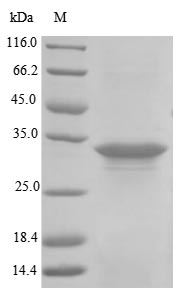Recombinant Staphylococcus aureus Alpha-hemolysin (hly) is produced in E. coli and covers the complete mature protein sequence from amino acids 27 to 319. SDS-PAGE analysis confirms this tag-free protein maintains purity levels above 85%. Researchers can rely on this preparation to study alpha-hemolysin properties, particularly its structural features and how it functions.
Alpha-hemolysin appears to be one of the most important components that Staphylococcus aureus produces. It's known for punching holes in host cell membranes. Being part of the toxin family, this protein helps the bacteria mess with cellular processes - which is why it has become such an interesting target for scientists trying to understand how bacteria cause disease and how they interact with their hosts. Research labs frequently work with this protein to figure out how it works and whether it might be a good target for new treatments.
Potential Applications
Note: The applications listed below are based on what we know about this protein's biological functions, published research, and experience from experts in the field. However, we haven't fully tested all of these applications ourselves yet. We'd recommend running some preliminary tests first to make sure they work for your specific research goals.
Based on the provided information, the recombinant Staphylococcus aureus Alpha-hemolysin (hly) is expressed in E. coli. Alpha-hemolysin is a pore-forming toxin that must undergo precise folding and heptameric assembly to function. While E. coli can express bacterial proteins, the correct folding and oligomerization of this complex toxin are not guaranteed. The protein is expressed as the full-length mature protein (27-319aa), which is favorable, but its activity is unknown. Alpha-hemolysin requires specific conformational states for membrane binding and pore formation, which may not be achieved in E. coli without proper folding conditions. Therefore, without experimental validation (e.g., hemolytic activity assay), the protein cannot be assumed to be correctly folded or bioactive.
1. Protein-Protein Interaction Studies
This application is highly dependent on correct folding. If the alpha-hemolysin is misfolded, it may not interact authentically with host cell membrane proteins or receptors, leading to non-physiological binding partners or false negatives. The mature protein form is relevant, but results are only reliable if the protein is natively folded. This application should be avoided until functional validation (e.g., erythrocyte lysis assay) confirms bioactivity.
2. Antibody Development and Characterization
This application is generally suitable. The recombinant alpha-hemolysin can serve as an immunogen for antibody production, as antibodies may recognize linear epitopes independent of folding. The mature protein sequence ensures coverage of epitopes present in natural infections. However, if the protein is misfolded, antibodies may not recognize the native, functional toxin. Antibodies should be validated against active toxin or native bacterial samples.
3. Biochemical and Biophysical Characterization
This application is appropriate and should be prioritized to assess folding. Techniques like circular dichroism, size exclusion chromatography, and dynamic light scattering can directly evaluate secondary structure, oligomeric state, and aggregation. These studies are valuable even if the protein is misfolded, as they provide critical data on the recombinant product.
4. In Vitro Membrane Binding Studies
This application is critically dependent on correct folding and bioactivity. Alpha-hemolysin's membrane binding specificity relies on its native conformation. If misfolded, liposome binding experiments will not reflect physiological interactions, leading to misleading data on lipid preferences or binding kinetics. This application should only be pursued after confirming the protein's hemolytic activity and oligomerization capability.
Final Recommendation & Action Plan
Given the uncertainty in folding and bioactivity, the priority is to validate the protein's function before most applications. Recommend first performing a hemolytic activity assay (e.g., using erythrocytes) to confirm pore-forming capability, followed by biophysical characterization (e.g., size-exclusion chromatography to check for heptamer formation). If active, the protein can be used for membrane binding and interaction studies; if inactive, focus on antibody development or as a control for biochemical analyses. Always include positive controls (e.g., native alpha-hemolysin) for functional assays, and consider optimizing expression conditions if folding issues are detected.






